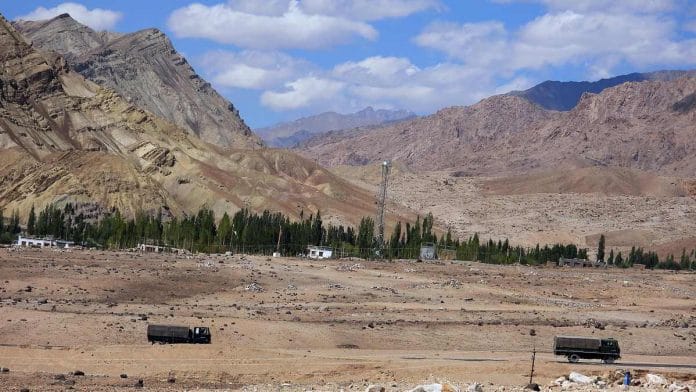New Delhi: With pull back at Pangong Tso over, India and China are now discussing disengagement at four more locations, two of which could take time, ThePrint has learnt.
This is because tensions at both the contentious areas — Depsang Plains and Demchok — trace their origin prior to the current round of tensions between the two countries that erupted in late April last year.
While initially, it was known that the areas under discussion for disengagement included Gogra, Hot Springs and Depsang Plains, sources in the defence and security establishment said it also included Demchok.
“There has been a minor transgression at Demchok where a few tents have come up, but this area is disputed,” a source said, adding that this is not a classical violation.
“It was on and off previously but since April, the Chinese had firmed up,” the source said.
Another source confirmed that Demchok is on the agenda of the Corps Commander level talks.
The tenth round of the Corps Commander level talks began at 10 am at the Moldo Meeting Point on the Chinese side.
The Indian side comprises Naveen Srivastava, Joint Secretary (East Asia) from the Ministry of External Affairs, besides officials from the defence and security establishment, and is led by 14 Corps Commander Lt Gen. P.G.K. Menon.
The Chinese delegation is being led by South Xinjiang military district chief Major General Liu Lin.
Also read: India ‘hyped’ Galwan casualties, distorted truth, says China ahead of Corps commander talks
Focus on Depsang Plains
Army sources said the focus is on Depsang Plains, which has a wider strategic ramifications, and the post-April transgressions in Gogra and the Hot Springs areas.
It is felt that disengagement at Gogra and Hot Spring could be tackled first since an understanding had already been reached in July last year for the same.
However, China had not fully completed the disengagement process and sought to keep a small group of soldiers just within a few meters of the Indian perception of the LAC.
ThePrint in August last year reported that tensions at Depsang Plains can be traced to China’s 18-km incursion into the area, which is close to the strategic Daulat Beg Oldi base, in 2013, and during the 2017 Doklam stand-off.
Sources said the issue in the Depsang Plains relates to China blocking Indian patrol parties from accessing Patrol Points (PP) 10, 11, 11A, 12 and 13.
This is because Indian patrol has to go beyond a feature called bottle neck area on foot, beyond which vehicles can’t be taken.
Less than a kilometre after this is an area called ‘Y’ junction, which has two routes — one going to PP 10, 11, 11A and 12, and the other goes directly to PP 13.
“This is where the Chinese come on vehicles and stop the patrol team. If need be, India can either push through physically or take an alternate route. A decision was taken to talk this out. Similarly, India has blocked Chinese patrol to their claim line,” a senior defence official had earlier said.
‘Both sides blocking each other’s patrol’
The Chinese perception of LAC is beyond the bottleneck area (around 18-20 km from LAC) and just 1.5 km from Burtse, where the Chinese reached in 2015 during President Xi Jinping’s India visit.
“It is both sides blocking each other’s patrol and is actually from a time period much before the April 2020 tensions,” a third source said.
Both India and China have ramped up their military presence in the area.
The Depsang Plains come under India’s Sub Sector North (SSN), which is sandwiched between the Siachen Glacier on one side and Chinese-controlled Aksai Chin, on the other.
As reported by ThePrint, it was sometime in 2015-16, India carried out a full-fledged war game taking into account possible multiple Chinese thrust into the SSN, with a focus on the Depsang Plains.
India has created a separate brigade to look after SSN following the 2013 tensions.
Sources said this brigade is the most diverse of the Indian Army with multiple war elements being a part of it.
Also read: Northern Army commander reveals how China was forced to negotiate Ladakh disengagement






